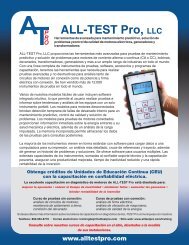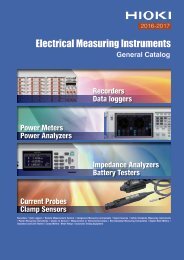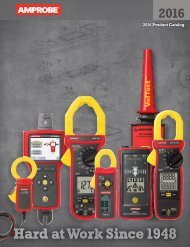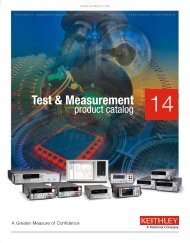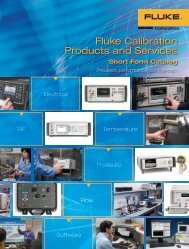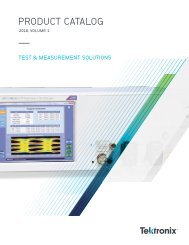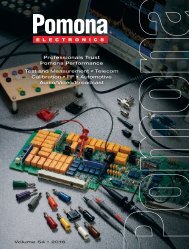Catalogo Raytek 2013
CEDE instrumentos de medición, distribuidor autorizado Raytek para todo México. Catalogo de termómetros IR 2013.
CEDE instrumentos de medición, distribuidor autorizado Raytek para todo México. Catalogo de termómetros IR 2013.
You also want an ePaper? Increase the reach of your titles
YUMPU automatically turns print PDFs into web optimized ePapers that Google loves.
For accurate temperature measurement the target<br />
size should be greater than the instrument’s field<br />
of view, or spot size. If the instrument’s spot size<br />
is larger than the target, the instrument will also<br />
measure energy emitted from the background<br />
or surrounding objects.<br />
determine the response or wavelength needed in a sensor. Highly reflective metals<br />
with different alloy compositions may have low or changing emissivities. The optimum<br />
wavelength for measuring high-temperature metal is around 0.8 to 1.0 micron. Since<br />
some materials are transparent at certain wavelengths, select a wavelength at which<br />
the material is opaque. A good choice for surface measurement of glass is 5 microns.<br />
Plastic films have transmission coefficients that vary according to the wavelength of<br />
the sensor and the thickness of the materials. Choosing 3.43 microns for polyethylene<br />
or polypropylene or 7.9 microns for polyester allows measurement of thin films.<br />
The recommended spectral response for low temperature applications is<br />
8 to 14 microns.<br />
Fast Response Time<br />
<strong>Raytek</strong> infrared temperature sensors reach 95%<br />
of the final temperature reading — a common<br />
definition of response time — much faster<br />
MI3<br />
than contact temperature sensors (such as<br />
thermocouples). This is particularly important when measuring quickly heated or moving objects.<br />
Newer <strong>Raytek</strong> infrared technology feature sensor response times down to one millisecond.<br />
Signal Processing<br />
Discrete processes, such as parts manufacturing, require instruments with signal processing<br />
(e.g., peak or valley hold and averaging). For example, using peak hold when measuring the temperature of discrete items on a conveyor<br />
prevents the temperature/sensor from reading the background temperature.<br />
Ease of Use<br />
<strong>Raytek</strong> infrared temperature sensors are easy and intuitive for plant operators to use. Depending on the<br />
model, a sensor’s output temperature can be seen directly on the unit, on a separate panel display,<br />
or on a PC monitor.<br />
Digital Output<br />
Digital output eases sophisticated temperature variation analysis. DataTemp<br />
Marathon MM Sensor MultiDrop software allows remote sensor configuration and temperature<br />
data acquisition. This data can be exported to other software applications.<br />
Temperature information can easily be archived, graphed, or printed to fulfill documentation needs with<br />
minimum expense.<br />
Environmental Considerations<br />
<strong>Raytek</strong> sensors are specified for performance within certain ambient temperature ranges. Dust, gases, or vapors<br />
can cause inaccuracies in measurement or can damage sensor lenses. Electrical noise, electromagnetic<br />
fields, and vibration are other conditions to consider before installation begins. A protective housing, air<br />
Thermojacket<br />
purging, or air or water cooling systems can protect the sensor and ensure accurate measurements.<br />
When steam, dust, or other particles degrade the measurement signal, choose a <strong>Raytek</strong> two-color instrument. Fiber-optic sensors,<br />
where the optical head is separated from the sensor electronics with a fiber-optic cable, also provide a solution around electromagnetic<br />
fields or other harsh environments.<br />
888 888<br />
888 888<br />
OVEN<br />
888<br />
888<br />
DRYER<br />
DIE<br />
COOLING<br />
<strong>Raytek</strong> sensors measure the temperature of hot, moving, or inaccessible materials safely, accurately, and with repeatability you can<br />
count on. As part of a process control loop, a <strong>Raytek</strong> sensor can help you improve and maintain product quality and provide the<br />
data needed to optimize throughput and minimize downtime.<br />
5




